Kingdom Animalia Subphylum Chelicerata Subclass Acari Rank Species | Phylum Arthropoda Class Arachnida Order Prostigmata | |
 | ||
Similar Aceria erinea, Aceria macrochela, Acalitus, Aceria, Eriophyes inangulis | ||
Aceria fraxinivorus, the cauliflower gall mite, causes the ash key gall that is found on the inflorecences commonly called the flowers or seeds. The hanging seeds are the "keys" of the common ash tree (Fraxinus excelsior).
Contents
Appearance and cause
The gall presents usually as a sizable irregular deformity formed from fused and swollen flower stalks (pedicels), however it has also been found on buds, leaf stalks, twigs or trunks. It is brown when fully formed, finally black, but green at first. Once the leaves have fallen, the galls, filled with mites, are very obvious within the trees branches and may remain for a year or more. Leaflets or entire leaves and petioles may also be involved, with additional distortions such as thickening and leaf lamina rolling, especially when the tree is heavily infested.
The cause of the gall are mites, mainly female, the eggs being viable without fertilization. These gall-mites are specialist species; they are cylindrical and feed on sap, and have no circulation or respiratory systems, only two pairs of legs and no eyes.
Distribution
The ash key gall is widespread in Britain; its numbers vary with the changes in annual seed production levels. In France and the Netherlands they are known as cauliflower galls.
Inquilines
Other acarine gall-mites, aphids, psyllids, and midges are often found within the galls.
Effects
Almost every inflorescence may be involved, the reproductive capacity therefore being reduced, however some seeds may still develop normally amongst the galls.
